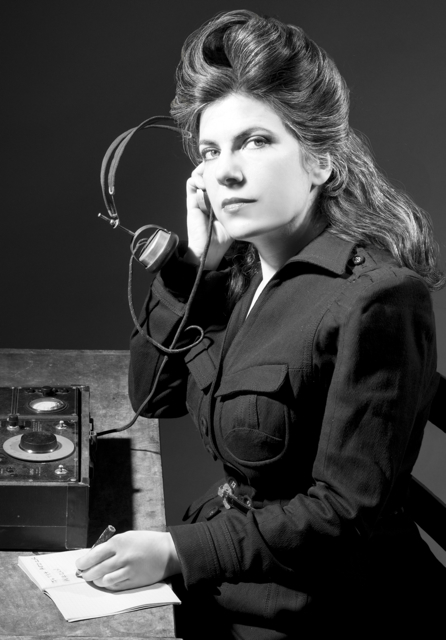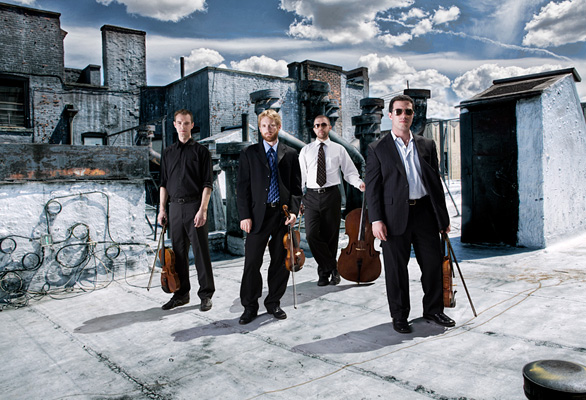No static at all in fascinating Gosfield premiere by JACK Quartet

Composer Annie Gosfield’s “Signal Jamming and Random Interference” was premiered by the JACK Quartet Sunday at Roulette.
Annie Gosfield is an excellent composer—part of the generation that can mix high concept with immediate, visceral communication, without self-consciousness. She has written many fine pieces that come out of her interests, at times almost obsessive, in baseball, industrial machinery and, at Roulette Sunday night, radio signal jamming.
JACK Quartet played three pieces, two that developed out of Gosfield’s research at the American Academy in Berlin on signal jamming during WWII—broadcasting records of sine waves, people speaking, chaotic noise—against enemy transmissions. This is a little known, even secret, history of technology and radio, and has manifested itself in our era through such disparate experiences as hearing a vocoder used in pop music, or seeing the terrifying transmissions from the future in John Carpenter’s movie Prince of Darkness.
Sunday’s concert opened with Lighthearted and Heavyhanded, a string quartet from 2002, written before Gosfield’s current explorations. The lightheartedness has to do, Gosfield explained in her notes, with vertigo. The piece moves from an intriguing, meditative tenebrous quality to an inward mournfulness. The clarity and exactitude of the composing were an ideal fit for JACK, which plays with a full body of sound in even the wispiest harmonics, and has such exquisitely precise intonation that Gosfield’s tight, quarter-tone dissonances sounded as beautiful and natural as any perfect interval.
Second on the program was Long Waves and Random Pulses, a solo violin piece—played by Christopher Otto—from 2012. This was an abstraction of the experience of trying to tune in a radio program that someone else was trying to jam. The form and style are almost neo-romantic, through composed, with roots in both Bach and Bartók’s Sonata for Solo Violin.
Otto played long, fluid lines that eventually morphed into sul tasto bowing—even col legno tratto—and the effect is that of the clarity and meaning of the music being suppressed and demolished by an outside force, the noise attacking the signal. The music is so expressive and so interesting that hearing it, with Otto’s expert and emotionally involved playing, was like witnessing intellect and romance struggle against the indifferent malevolence of brute force and cynicism. Gosfield may not have consciously intended to stake out such fundamental ground, but the music does so regardless, especially give the context of the past weeks in America.
After intermission came the substantial—about forty-five minute—world premiere of Signal Jamming and Random Interference, for the quartet and audio that Gosfield controlled from a laptop and a mixer. This is a fascinating, obdurate work, with a mysterious, dark core. Gosfield explained how she originally meant to make a tape piece with the string quartet accompanying, but working with JACK’s ability to handle extended techniques, she transferred the sound of the signal jamming material to the instruments.
The result is a mix of astonishing sounds, including that of the bow being drawn across a practice mute, which produces something like breathing through a filter of white noise, and much intensely brittle pizzicato. The playing and composing managed to capture a real sense of beauty, all the while using techniques that strike the ear aggressively, and that seem to carry an inherent feel of the horrific conflict from which they arose.
The glassiest harmonics sounded uncannily like abstract radio signals, while the mix of tones, thumps, and distortion from the audio track had an eerie, otherworldly lifelessness, like an attack of intelligent machines. The score has a brief quote from Beethoven’s Op. 74, No. 1, “Harp” quartet, and the audio throws that snippet, with distortion, aggressively back at the musicians.
The intense physicality of the music makes it indomitable, and the clear sense of structure and form is an implicit argument for logic and determination against chaos. There are great, slowly churning cadences where the music digs itself in a half-step below, then pushes up with strength to the tonic, bowed and unbowed, and the tremendous industrial sound that JACK made at the end was a triumph for creation over the detritus of history.



